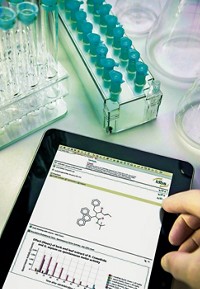Advertisement
Grab your lab coat. Let's get started
Welcome!
Welcome!
Create an account below to get 6 C&EN articles per month, receive newsletters and more - all free.
It seems this is your first time logging in online. Please enter the following information to continue.
As an ACS member you automatically get access to this site. All we need is few more details to create your reading experience.
Not you? Sign in with a different account.
Not you? Sign in with a different account.
ERROR 1
ERROR 1
ERROR 2
ERROR 2
ERROR 2
ERROR 2
ERROR 2
Password and Confirm password must match.
If you have an ACS member number, please enter it here so we can link this account to your membership. (optional)
ERROR 2
ACS values your privacy. By submitting your information, you are gaining access to C&EN and subscribing to our weekly newsletter. We use the information you provide to make your reading experience better, and we will never sell your data to third party members.
Business
Benchtop Informatics
Accelrys is pushing to expand its market with electronic laboratory notebooks
by Rick Mullin
June 6, 2011
| A version of this story appeared in
Volume 89, Issue 23

Max Carnecchia, chief executive officer of Accelrys, took the stage at the company’s North American User Group Meeting in Jersey City, N.J., last month beneath a large schematic of its flagship product, Pipeline Pilot. The image, which explains the workings of the scientific research informatics system—software that integrates modeling, simulations, and other research applications with scientific databases and analytical tools—has been updated since last year’s meeting. This year, it illustrates the integration of a new line of products: electronic laboratory notebooks (ELNs).
With its 2010 acquisition of Symyx, a leading supplier of ELNs, Accelrys added a benchtop information technology (IT) tool to Pipeline Pilot. The Symyx acquisition also gave Accelrys a foothold in one of the fastest-growing research IT markets. Sales of ELN software will grow by about 20% to $122 million worldwide next year, according to Atrium Research & Consulting.
Carnecchia told the users in New Jersey, however, that the Symyx acquisition will drive more fundamental growth for all the company’s products. “Historically, we have been mostly focused on research,” he said, noting the company’s genesis as a supplier of chemical and materials modeling software. “Now, with Symyx, we extend the sharing of scientific information up and down the value chain to development and early manufacturing scale-up.”
Days after the user meeting, the company announced its acquisition of Contur, a supplier of Web-browser-based ELN products for small, nonpharmaceutical laboratories. Carnecchia tells C&EN that Accelrys, which currently accrues about 70% of its revenue in the life sciences sectors, hopes to make chemicals, oil and gas, consumer packaging, and academic research 50% of its business in five years.
The competitive landscape has changed dramatically since last year, however, with PerkinElmer also purchasing two ELN companies, including the market leader, CambridgeSoft. With projected sales under $160 million this year, Accelrys will now vie with a $1.7 billion scientific instrumentation giant for dominance at the laboratory bench. Carnecchia is counting on Accelrys’ focus on lab informatics, and Pipeline Pilot in particular, to give his company a leg up.
Firms like Accelrys and PerkinElmer are responding to rapid changes in research IT. Companies, especially in the drug industry, are scrambling to support increased information sharing among their discovery, development, and manufacturing organizations. Greater collaboration with external partners only heightens the need to integrate ELN software as a component of laboratory informatics. “It’s become apparent that these businesses do not have the scientific software infrastructure required to take them where they want to go,” Car nec chia says.
It was earlier apparent to Carnecchia that, to help them get there, Accelrys needed to extend its workhorse informatics platform through acquisition. Symyx was identified as a key opportunity, he says, given both the complementary nature of its product line with Accelrys’ and its large installed base in drug development labs. Symyx, he notes, had emerged as one of the top three players in the fast-growing, competitive ELN market.
The histories of both companies reflect big changes in laboratory IT. “Accelrys started about 20 years ago with modeling and simulation at a time when it was hoped that new drugs and chemicals would be designed almost exclusively in silico,” Carnecchia says. Symyx, on the other hand, started in 1996 as a specialist in high-throughput instrumentation for materials discovery when high-throughput techniques were all the rage.
Accelrys, which continues to market its modeling software, moved into informatics with the acquisition of Pipeline Pilot from SciTegic in 2004. Symyx shifted its focus to software development. In 2005, it purchased two ELN firms, IntelliChem and Synthematix. The merger of Accelrys and Symyx, Carnecchia says, provides an opportunity to put together the kind of integrated IT platform that researchers require.
That opportunity is not lost on PerkinElmer, which, in addition to buying CambridgeSoft, bought ArtusLabs, another ELN supplier, and Labtronics, a laboratory IT integration software firm, all within a matter of weeks. Carnecchia says the competition will focus on informatics expertise, where Accelrys is well positioned. “Of the 550 employees at Accelrys, nearly 200 are Ph.D. scientists,” he says. “We can sit across from our customers and understand them. We have the requisite domain expertise.”
Trevor W. Heritage, executive vice president for software products at Accelrys and former president of Symyx’ software business, says the combination of the two firms unifies “several technology pieces that the two companies had that weren’t quite integrated or accessible in such a way that a scientist would feel comfortable with them.”
For example, he says, the Symyx ELN helps pharmaceutical researchers investigate crystal forms of a drug or other kinds of polymorphism, whereas Accelrys’ Materials Studio application allows them to model crystals. “What scientists want is an experimental framework, like a notebook, where they can pull in the modeling and simulation data to complement the experiments they need to do,” Heritage says.
The unifying principle, he says, is Pipeline Pilot. And Symyx’ ELN, he says, enables researchers to efficiently manage experimental data and analysis using the informatics backbone. “You used to have to start five applications on a desktop computer and move the data between them,” he says. “Now, Pipeline Pilot is doing required data transformation in the background.” The researcher can collect and summarize data, calculate properties, generate charts and publish them to a Web page in a couple of clicks on a notebook.
Another advantage in acquiring Symyx, Heritage notes, is its installed base in the D part of R&D. “There is a real drive by our customers to understand what Pipeline Pilot can do in the development environment,” he says. Integrating the two companies will foster data sharing between drug discovery and development. “All the disciplines have to work together to get to an active ingredient,” he says.
Collaboration is just as important in other industries, says Carnecchia, describing Accelrys’ latest acquisition. Drawing on cloud computing, the Contur ELN positions Accelrys for growth in a large, primarily nonpharmaceutical market for laboratory IT. “The ELN market is like a pyramid,” he says, “with the biggest customers having the most requirements on the top. Symyx has traditionally been on the top of the pyramid with ELN that is hard-coded and connected to other applications and instruments where FDA validation is required.” Contur’s ELN targets the lower part of the pyramid, which is composed of small academic laboratories and medium-sized businesses that don’t have a lot of IT resources or require Food & Drug Administration validation.
“No matter the size of the organization, collaboration needs to happen at a faster pace now,” he says. “Between Symyx and Contur, we have the complete waterfront covered.”
This was not the case prior to the Symyx acquisition, according to Michael Elliott, president of Atrium Research. “Pipeline Pilot is a data aggregation, integration, and analysis tool set,” he says. “The challenge is that there were one or two people in the user organization who could put together the protocols to solve a particular problem. The system was not pervasive across the grand laboratory ecosystem.” Symyx’ ELN, however, potentially puts Pipeline Pilot on every researcher’s benchtop.
Elliott agrees with Carnecchia that broader access among scientists could also push Pipeline Pilot downstream from basic research into development. Although Pipeline Pilot had the ability to define data analysis workflows, ELN allows users to access the data (including data from public sources), interpret the data, and design experiments.
Meanwhile, the Contur acquisition could open new markets for Accelrys, Elliott says. “The public cloud has really been the purview of small companies and academic and government labs,” he says, “markets Accelrys traditionally hasn’t played in.”
Elliott says he is not surprised that Accelrys acquired a second ELN company so soon after buying Symyx, especially given Perki nElmer’s recent activity. Some amount of catch-up may be involved, he notes. “Accelrys missed a major window of opportunity for jumping into ELN in a big way,” he says, claiming that an acquisition as early as 2003 would have given the company a leg up.
According to Elliott, Accelrys leads the market in process chemistry and formulation but lags IDBS, the third major ELN supplier, in biology research, especially in vivo pharmacology. Overall, he says, PerkinElmer dominates the ELN space with a 30% share. Accelrys and IDBS hold about 15% each. In the wake of the recent acquisitions, Elliott adds, Accelrys will be countering PerkinElmer’s size and diversity with its claim of focusing entirely on laboratory informatics.
Carnecchia says growth, perhaps through further acquisitions, is on the front burner at Accelrys. In addition to pushing beyond pharmaceutical research, the company is stepping up to biotechnology, most recently with a new suite of genomics research applications for Pipeline Pilot. The company signed an agreement with Oxford Nanopore, a manufacturer of single-molecule-analysis DNA-sequencing technology, under which Oxford will market the Accelrys genomics suite with its sequencers.
Carnecchia emphasizes the primacy of Pipeline Pilot as an extendable platform that can integrate with most existing laboratory IT and adapt to future needs. But the firm’s biggest opportunity for growth, he says, is the inclusion of ELNs as an integral component.
“When you look at the ELN segment, you see that we are very early in the game. There is massive room for growth in ELN. People talk about it being the second inning,” he says. “Most scientists and engineers are still documenting experiments—their hypotheses, their results—on paper.”





Join the conversation
Contact the reporter
Submit a Letter to the Editor for publication
Engage with us on Twitter